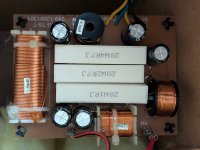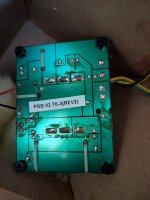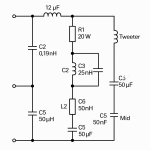Howdy folks
As I found there is limited information about PSB Image series speakers available and even less on their crossover design, schematics and replacing aging parts I wanted to start this thread and share my findings.
I have been going down a rabbit hole of understanding crossovers and the effect different components and combinations can have on audio quality, poly caps, foil caps, mills resistors etc etc. to figure out what I should do i.e. like for like or put something new and improved.
I have a pair of PSB Image T6 floor standing 3 way speakers, purchased second hand for a reasonable price circa $200 AUD. they work and sound okay but I have noticed some degredation in the mid and high frequency, especially when comparing to a pair of T5 towers, B5 bookshelve and C5 centre channel performance.
T6 are a twin front ported design with 2 * 6.5inch, a dedicade 5.25inch midrange in its own box at the top and the aluminium dome tweeter between mid and top woofer. Crossovers are 500hz/2200hz.
First up I have removed the mid/tweet/first woofer and measured the resistance and are showing the following 4.3ohm/3.2ohm/8.6 ohm and figure these are within spec.
Next up check the 2 crossovers, first is behind the terminals and a second which behind the tweeter.
Nothing appears to be bulging from the top and most components look to be in reasonable condition, upon checking the undersides though it appears there is some residue of some sort which brings me to my first question.
Does this suggest that due to the age of the speakers(roughly 20 years) they could be leaking and be causing audio degredation?
I had Chatgpt draw me up a diagram to help with swapping out components for new which I hope is accurate?
Cheers.
As I found there is limited information about PSB Image series speakers available and even less on their crossover design, schematics and replacing aging parts I wanted to start this thread and share my findings.
I have been going down a rabbit hole of understanding crossovers and the effect different components and combinations can have on audio quality, poly caps, foil caps, mills resistors etc etc. to figure out what I should do i.e. like for like or put something new and improved.
I have a pair of PSB Image T6 floor standing 3 way speakers, purchased second hand for a reasonable price circa $200 AUD. they work and sound okay but I have noticed some degredation in the mid and high frequency, especially when comparing to a pair of T5 towers, B5 bookshelve and C5 centre channel performance.
T6 are a twin front ported design with 2 * 6.5inch, a dedicade 5.25inch midrange in its own box at the top and the aluminium dome tweeter between mid and top woofer. Crossovers are 500hz/2200hz.
First up I have removed the mid/tweet/first woofer and measured the resistance and are showing the following 4.3ohm/3.2ohm/8.6 ohm and figure these are within spec.
Next up check the 2 crossovers, first is behind the terminals and a second which behind the tweeter.
Nothing appears to be bulging from the top and most components look to be in reasonable condition, upon checking the undersides though it appears there is some residue of some sort which brings me to my first question.
Does this suggest that due to the age of the speakers(roughly 20 years) they could be leaking and be causing audio degredation?
I had Chatgpt draw me up a diagram to help with swapping out components for new which I hope is accurate?
Cheers.
Attachments
Crossover schematic diagram is so wrong, I am speechless.
Because you bought second-hand loudspeakers, there is a possibility that some of the drivers may be partially damaged, especially tweeters.
Because you bought second-hand loudspeakers, there is a possibility that some of the drivers may be partially damaged, especially tweeters.
Aside from the possibility of some damage to the drivers, these are hands down the worst speaker crossover parts out there.
Chat GPT has no idea, that diagram is nonsense. 🙄
You need to find someone who knows a little about speakers if you want to have schematics.
You can clean the PCB with isopropyl alcohol.
The only thing you can do is to find new such radial bipolar electrolytic capacitors with identical values of capacity, voltage and physical dimensions and replace them.
Chat GPT has no idea, that diagram is nonsense. 🙄
You need to find someone who knows a little about speakers if you want to have schematics.
You can clean the PCB with isopropyl alcohol.
The only thing you can do is to find new such radial bipolar electrolytic capacitors with identical values of capacity, voltage and physical dimensions and replace them.
Last edited:
As others have said the schematic is a disaster. None of the crossover components will degrade over time except the capacitors.
Nothing inherently wrong with decent non polar electrolytics but they can dry out over time.
Nothing inherently wrong with decent non polar electrolytics but they can dry out over time.
https://www.soundstagenetwork.com/measurements/speakers/psb_image_t6/
Shows them to be competently designed. You definitely got a lot of speaker for your $200.
Shows them to be competently designed. You definitely got a lot of speaker for your $200.
Thank you for providing this diagram!!
the values of the caps and L3 are as follows
C2 50uf
C5 25uf
C4 12uf
C1 50uf
C3 15uf
L3 0.3mh
the values of the caps and L3 are as follows
C2 50uf
C5 25uf
C4 12uf
C1 50uf
C3 15uf
L3 0.3mh
Thanks for the reply.Aside from the possibility of some damage to the drivers, these are hands down the worst speaker crossover parts out there.
Chat GPT has no idea, that diagram is nonsense. 🙄
You need to find someone who knows a little about speakers if you want to have schematics.
You can clean the PCB with isopropyl alcohol.
The only thing you can do is to find new such radial bipolar electrolytic capacitors with identical values of capacity, voltage and physical dimensions and replace them.
Will clean up the PCB as you suggested,
Finding the right values as radial electro caps is proving to be difficult, all the electros I can find are axial with some needing to be paralleled to get matching values, I was wondering if it might be worth replacing them with poly caps if they can fit and not cause any other issues.
I do plan to test the drivers but need a mic and maybe a dats.
Nixie62 re the resistors being 20w, I have no idea sorry.
It's a linkwitz-riley 4th order crossover, speakers rated at 6ohms.
Not sure if that info helps
Cheers
It's a linkwitz-riley 4th order crossover, speakers rated at 6ohms.
Not sure if that info helps
Cheers
I don't see any room for polycaps there. There is a big difference in the ESR of bip. electrolytes and polycaps. The replacement disrupts the entire crossover because the crossing frequencies depend on the resistance. Capacitance and ESR deviations are particularly problematic with higher order filters.
- Home
- Loudspeakers
- Multi-Way
- PSB Image T6 - crossover updates


